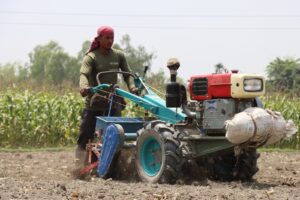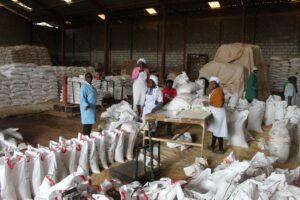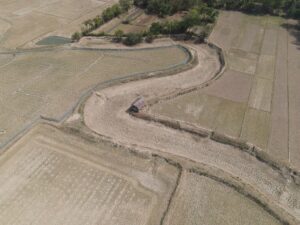Planthopper outbreaks are associated with insecticide use and researchers have looked for alternative methods to manage these pests. Because of the vagaries of insecticides, which depend on the frequency and timing of applications as well as interactions with the host variety and environment, farmers should ensure that natural enemies are conserved in their rice fields and that ecosystem resilience is maintained by planting resistant rice, but avoiding insecticide use.
Because planthopper outbreaks are associated with insecticide use, researchers have looked for alternative methods to manage these herbivores. Over the last 50 years, public research has mainly focused on developing high-yielding rice varieties with resistance to planthoppers. Already, over 60 genes for resistance to planthoppers have been identified from traditional rice landraces or wild rice species.
Many of these have been incorporated into high-yielding varieties through marker-assisted selection, and a number of varieties have been deployed to farmers’ fields. However, intense research into host resistance has not resulted in any predictable decline in insecticide use. Indeed, during the time that research into host plant resistance has been most intense, insecticide use in Asia dramatically increased.
This implies that resistant rice varieties are likely to be treated with insecticides by farmers who are generally unaware of the resistance traits associated with their chosen varieties. This is significant because certain pesticides, and particularly pyrethroid insecticides, can increase the susceptibility of rice plants to herbivory by, for example, directly increasing sugar concentrations or reducing phenol concentrations.
Furthermore, planthoppers treated with pyrethroids sometimes exhibit enhanced fitness as part of a stress response to toxicity. These effects are exacerbated where insecticide applications result in greater mortality of natural enemies than target herbivores, or where the predatory behaviors of natural enemies are impeded, thereby reducing the regulatory ecosystem services provided by, for example, parasitoids and spiders.
Therefore, insecticides could directly reduce the effectiveness of resistant rice varieties against planthoppers. At field scales, such interactions between insecticides and crops of resistant rice can result in profitability losses for farmers and erode the durability of resistance genes.
Integrated Pest Management (IPM) recommends that farmers only use insecticides when target pests exceed identified economic threshold densities. However, ascribing threshold densities for different pests under variable climates and on varieties with different levels of resistance or tolerance is challenging, and published threshold densities can vary widely.
Furthermore, farmers are often unable to adequately monitor their rice fields to assess herbivore populations and the corresponding risks these herbivores pose to crop yields. In this context, agrochemical suppliers frequently promote prophylactic insecticide applications that are based on crop stages or calendar dates, and not on pest risks.
The potential for some pesticides to cause herbivore resurgence, combined with applications that are not correlated with risks, will destabilize planthopper populations. Resistant hosts can buffer against these effects; however, because target herbivores may never arrive to the crop, or never exceed threshold densities, and because certain pesticides will also directly reduce rice yields, prophylactic applications are more likely to lead to losses in rice profitability than are threshold-based applications.
We conducted our experiments using the rice variety IR62 which is highly resistant to planthoppers in South and Southeast Asia and compared this with an Asian mega-variety, IR64, that is susceptible to planthoppers. We applied seven commonly used insecticides, without mixing products, during the experiments. We applied the insecticides at different frequencies (i.e., one, two, or three applications) and at different growth stages (one application at 20 days after sowing or one at 50 days after sowing).
We found evidence that resistance with single applications of some insecticides gives better control of BPH than either method alone. Resistance also buffered against resurgence by deltamethrin, but the same insecticide was antagonistic to the host’s resistance after repeated applications. Each of these effects was weak in our experiments. Many of the insecticides were ineffective in our experiments and their use for BPH control on resistant rice was therefore redundant.
Meanwhile, the combination of effective insecticides (carbofuran, fipronil) with resistance or multiple applications of less effective insecticides (cartap hydrochloride, cypermethrin) resulted in redundancy of resistance and a loss of synergies. Among the products we examined, three products (carbofuran, fipronil and cypermethrin) reduced BPH densities and biomass densities when applied after planthoppers had colonized the rice plants.
However, at least two of these products, carbofuran and fipronil, have severe impacts on farmers and pesticide applicators or on wildlife, and cypermethrin and fipronil can also directly reduce rice yields.
Because of the vagaries of insecticides, which depend on the frequency and timing of applications as well as interactions with the host variety and environment, farmers should ensure that natural enemies are conserved in their rice fields and that ecosystem resilience is maintained by planting resistant rice, but avoiding insecticide use.
Read the study
Horgan FG, Peñalver-Cruz A. (2022) Compatibility of Insecticides with Rice Resistance to Planthoppers as Influenced by the Timing and Frequency of Applications. Insects; 13(2):106.






